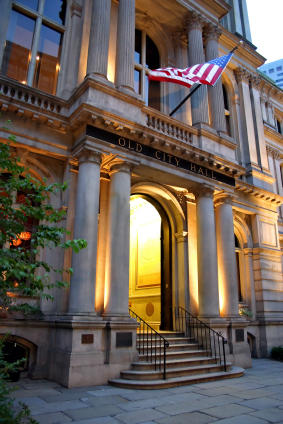
By Joel Kotkin and Mark Schill
Ever since the 1930s, most urban areas have leaned Democratic. But in presidential elections, many remained stubbornly competitive between the two parties. As late as 1988, for example, Republican nominees won Dallas County and made strong showings in the core urban counties of Cook (Chicago), Los Angeles and King (Seattle).
Today, America’s urban areas have evolved into a political monoculture that increasingly resembles the “solid South” that provided a base for Democrats from the late 19th century to the 1960s. Since 1972, the year of the Nixon landslide, the Democratic share has grown 20 percent or more in most of the largest urban counties.
As a result, places where Republicans such as Ronald Reagan could once win a respectable share of the vote — including San Francisco, Philadelphia and New York City — by 2004 were delivering 80 percent or more to the Democrats. Even in the losing year of 2004, Democratic nominee John F. Kerry won almost every city of more than 500,000 people.
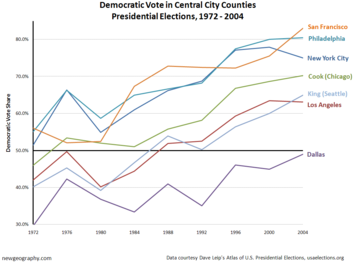 This fall, Barack Obama, a resident of Chicago, can comfortably expect to triumph in virtually every major urban county, often by ratios of 2-to-1 or more. He can count just as much on cities in decline as he can on those that have been gentrified; he will rack up big margins both in heavily white core counties such as those around Minneapolis and Portland, Ore., as well as overwhelmingly minority Baltimore, Philadelphia and the Bronx, N.Y.
This fall, Barack Obama, a resident of Chicago, can comfortably expect to triumph in virtually every major urban county, often by ratios of 2-to-1 or more. He can count just as much on cities in decline as he can on those that have been gentrified; he will rack up big margins both in heavily white core counties such as those around Minneapolis and Portland, Ore., as well as overwhelmingly minority Baltimore, Philadelphia and the Bronx, N.Y.
Race and income levels do not explain the emerging urban monoculture, because the cause lies elsewhere: in the evolution of cities over the past four decades. The shift began in the late 1960s, when urban regions, from financial centers such as New York and Chicago to old industrial cities such as Detroit and Cleveland, began to suffer a massive exodus of predominantly white, middle-class residents.
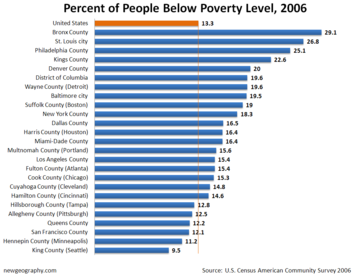 This left behind an increasingly impoverished, highly minority population with very little proclivity to support conservative or even moderate Republicans. Today in some cities — mostly old industrial centers in the East and Midwest — this population remains dominant and is likely to vote in huge numbers for Obama. Most of these cities suffer poverty rates at least 50 percent higher than the national average.
This left behind an increasingly impoverished, highly minority population with very little proclivity to support conservative or even moderate Republicans. Today in some cities — mostly old industrial centers in the East and Midwest — this population remains dominant and is likely to vote in huge numbers for Obama. Most of these cities suffer poverty rates at least 50 percent higher than the national average.
At the same time, some other cities — such as New York, Chicago, Boston, San Francisco, Seattle and Portland — have done far better. They have done so by attracting a population of well-educated, white professionals. Pockets of this demographic, to be sure, also exist in some hard-hit industrial cities, but the new urban affluents tend to concentrate in cities with industries, such as financial services and media, that provide excitement and the prospect of high-wage employment in a glamorous setting.
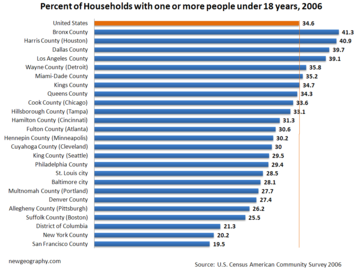 Many new urbanites tend to be students or professionals enjoying city life during their first, highly experimental years of adulthood. At this point, they are most open to liberal ideas and causes; they have yet to worry much about taxes and crime, issues that drive people to the center. As they grow older, marry and raise families, many in this cohort — particularly those who do not ascend into the upper classes — leave the urban core for the suburbs or other more affordable regions.
Many new urbanites tend to be students or professionals enjoying city life during their first, highly experimental years of adulthood. At this point, they are most open to liberal ideas and causes; they have yet to worry much about taxes and crime, issues that drive people to the center. As they grow older, marry and raise families, many in this cohort — particularly those who do not ascend into the upper classes — leave the urban core for the suburbs or other more affordable regions.
Yet if the urban base — roughly 30 percent of the population — offers Obama a huge edge in the election, he must not identify too much as an urban candidate. In the past, the danger for Democrats lay in being perceived as paying too much heed to poor, minority voters. Fortunately, Obama, as an African-American, has little need to compete for their affections.
More tempting, however, might be to embrace the emerging agenda of the benefactors of gentrification: powerful real estate interests and other groups. Among them are vocal constituencies who are openly hostile to people in suburbs and small cities. This ideology first emerged in 2004 in John Sperling’s “Retro vs. Metro” thesis, which envisioned the eventual triumph of a sophisticated urban population over backward-seeming rural, small town and suburban constituencies.
An even clearer example of this urbanist ideology came in the wake of Kerry’s 2004 defeat, largely at the hands of rural, small-town and exurban “retro” voters. Editors of The Stranger, a Seattle alternative weekly, pointed out in an article that “if the cities elected our president, if urban voters determined the outcome, John F. Kerry would have won by a landslide.” Their solution was not to reach out to the other geographies, but to build an “urban identity politics” to counter Republicans’ hold over suburban and rural voters.
“From here on out, we’re glad red-state rubes live in areas where guns are more powerful and more plentiful, cars are larger and faster, and people are fatter and slower and dumber,” The Stranger proclaimed. Given the editors’ uninhibited sense of superiority, they felt confident that in the emerging Darwinian struggle, the suburban and exurban Neanderthals would be forced to give way to the clear superiority of the urban Cro-Magnons.
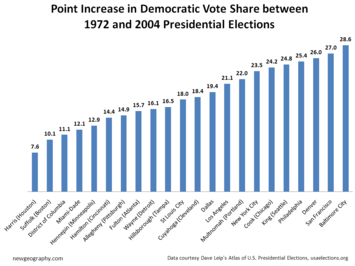 Since 2004, this ideology has become stronger, ironically bolstered by two bubbles fostered by President Bush’s fiscal policy: the boom in city condominium development and the rapid expansion of the financial services industry. Even as 80 percent to 90 percent of metropolitan growth redounded to the suburbs, the rising affluence of the urban cores persuaded the media that cities were not only back but were also reasserting their historic ascendance over the periphery.
Since 2004, this ideology has become stronger, ironically bolstered by two bubbles fostered by President Bush’s fiscal policy: the boom in city condominium development and the rapid expansion of the financial services industry. Even as 80 percent to 90 percent of metropolitan growth redounded to the suburbs, the rising affluence of the urban cores persuaded the media that cities were not only back but were also reasserting their historic ascendance over the periphery.
In recent months, the city-centered media such as CNN, The New York Times and National Public Radio have jumped on the urbanist bandwagon. They have promoted urban chauvinists’ contention that high gas prices and legislation to limit global warming would end the era of dispersion. This return to a more urbanized demography, some Democratic bloggers suggest, would assure a new liberal ascendancy.
Whatever Obama may believe personally, he would be well-advised to distance himself from such sentiments. For one thing, identifying with people who celebrate the demise of other geographies may offend the majority of Americans who prefer to live in “retro,” lower-density environments. Suburb- and countryside-bashing may turn on editors and readers of The New York Times, but it hardly constitutes good politics.
In terms of political strategy, Obama would be far better off stressing the commonalities between people in differing geographies. His time on the campaign trail should tell him that laid-off paper industry workers in central Wisconsin, hard-pressed suburban homeowners in San Bernardino, Calif., and struggling inner city residents in Brooklyn have ample cause to reject an extension of Republican rule. Why repeat the Bush tactic of dividing people from each other, this time based on where they choose to live, when the economic misery is so well-distributed?
By displaying genuine empathy for Americans living in suburbs and small towns as well as in cities, Obama could achieve more than a small tactical victory, à la Karl Rove. With a strong showing in the other geographies as well as his inevitable landslide in cities, he could instead realize a historic triumph closer to Rooseveltian proportions.
Joel Kotkin is a presidential fellow at Chapman University and executive editor of www.newgeography.com. Mark Schill is the website’s managing editor and a community strategy consultant with Praxis Strategy Group.
This article originally appeared at Politico.
Other articles in the Three Geographies Series:
The Three Geographies
Rural America could bring boon to Dems
Suburbs will decide the election
| Attachment | Size |
|---|---|
| Three-Geographies-Cities.pdf | 621.31 KB |












